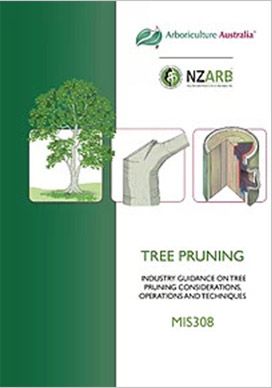
MIS308 Tree Pruning
MIS308 Tree Pruning - 2nd ed.
Minimum Industry Standard series Members Price is for Members of The New Zealand Arboricultural Association (NZARB). The vision of NZ Arb is to represent the arboriculture community and make it the primary organisation for tree care and to maintain relevancy to the Association’s members, so if you are in the NZ tree care industry please consider joining NZARB by clicking the link above if you are not already a member. |
This book is one in a series of Minimum Industry Standards produced by Arboriculture Australia Ltd and the New Zealand Arboricultural Association in consultation with the national arboriculture community in both countries. These industry peer-reviewed documents provide a ‘body of knowledge’ which is shared by practitioners and can be used as the basis for training, dissemination of skills and professional development.
This document covers the work task of tree pruning, including a brief summary of the underpinning knowledge necessary to select and perform suitable pruning operations to achieve a variety of objectives. This document is not a ‘standalone’ document, and must be read in conjunction with other Minimum Industry Standards which describe safe arboricultural work practices.
Contents:
Pruning trees
1: Pruning considerations Tree health considerations
Tree structural considerations
Ecological considerations
2: Pruning operations
R: Reduction pruning
T: Crown thinning AC: Asset clearance
C: Crown lifting RA: Risk abatement pruning
| H: Remedial pruning RT: Retrenchment pruning
F: Formative pruning SP: Structural pruning ER: Epiphyte / parasite and vine removal P: Pollarding PP: Palm pruning Poor pruning practices
3: Conducting pruning Tree pruning permits and tree protection laws Tools and equipment for tree pruning Biosecurity measures
Tree access for pruning Making pruning cuts
Pruning cuts
Completing tree works
The care of trees
|
Minimum Industry Standards
The Minimum Industry Standard series is dedicated to all our fellow workers who have lost their lives or have been permanently injured working in the arboriculture and vegetation management industries.
The Minimum Industry Standards project is an Arboriculture Australia led initiative that the NZ Arb is pleased and proud to be involved with. Having joined the programme, NZ Arb works alongside Arboriculture Australia to develop these Minimum Industry Standards. Each Minimum Industry Standard (MIS) provides the key knowledge that is necessary to perform the work task.
| Dimensions | 150 x 210 mm |
| Pages | 169 |
| Cover | Soft Cover |
| Binding | Wire-O |
